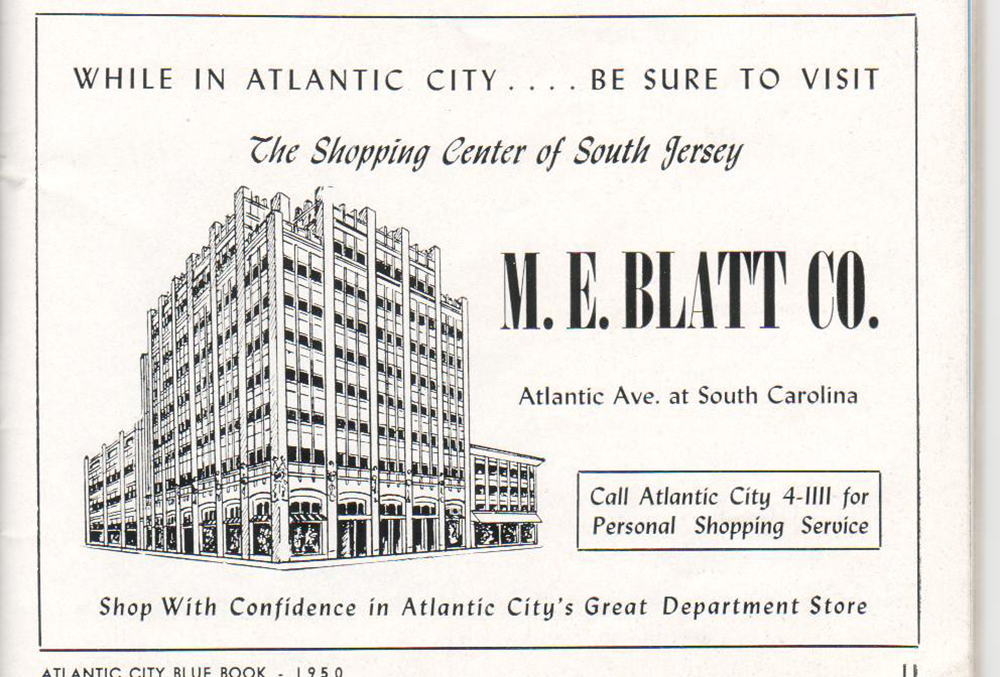By Bruce Klauber
There was a time, from around the early 1930s to the late 1960s, when Atlantic City was a shopper’s paradise. All types of retail stores lined Atlantic and Pacific avenues, to say nothing of the shops on the Boardwalk. Customers could buy anything from a snare drum to a wedding gown and everything in between.
While people who recall those days mention stores like Woolworth’s on Ocean Avenue and the Boardwalk, The California Shop, Petrie’s, Irv’s Music and Homberger’s clothing, the focal point of Atlantic City’s retail business for almost seven decades was the M.E. Blatt Department Store, at South Carolina Avenue and the Boardwalk. It was billed as “Atlantic City’s Great Department Store,” and occupied that corner from around the mid-1920s until 1977.

Host and columnist for WPG Talk Radio Harry Hurley detailed Blatt’s history in a column written in September 2023. “A couple named Bertha and Samuel Braunstein opened a dry goods business on Atlantic Avenue in about 1900, around the turn of the century,” Hurley wrote. “During these times, Atlantic City had mostly small dry goods stores, with the only department stores being satellite Philadelphia stores.
“The Braunsteins were visionaries and created the first metropolitan-style store in Atlantic City. From there, their son, David Braunstein, formed a partnership with Max Blatt. Blatt had a number of other business interests in Atlantic City. Blatt quickly bought the Braunstein interest in the business and proceeded to move the store one block away to 1300 Atlantic Avenue at South Carolina Avenue. Blatt’s death resulted in the store being sold to the Philadelphia-based Bankers Securities chain.”
The Snellenburg Department Store chain acquired Blatt’s in 1958, and the store existed as Snellenburg’s until 1962. When the company closed its downtown Philadelphia location in that year, the other stores in the Snellenburg chain, including the one in Atlantic City, were sold to Lit Brothers.
Although the long pre-gambling decline of the city started in the mid-1960s, Lit miraculously held on until 1977. At that point, the situation for retail stores, especially department stores in Atlantic City, was not good.
“In a city that will soon be filled with gambling casinos and new hotels, it’s hard to believe that a shopper cannot find a single department store,” said an August 1977 story in The New York Times. “The city has been living without one stop shopping since Lit Brothers of Philadelphia closed its nine-story department store earlier this year. No one is rushing in to fill the vacuum. ‘As far as we know, there is next to nothing being done,’ says William Eames, Managing Director of the local Chamber of Commerce.’
“Spokesmen for Philadelphia’s three major department store chains – Wanamaker’s, Gimbels and Strawbridge & Clothier – say they have no plans at present for opening stores in Atlantic City. If any decision is made to move in, it could take more than two years before a major store could open, according to one department store executive.”
It never materialized.
“A study of the impact of gambling casinos, done by a Washington based consultants’ group, predicted the creation of 4,060 new jobs and investments of $26 million in expansion and construction of retail stores in Atlantic City by 1985. ‘We’re not aware of any of that money being spent yet,’ Eames said.

“The retail industry has been very slow to respond. The retailers are the last ones in. They want to hold off until the last minute to find out what kind of market they will have.”
Though a new department store never happened, something else did. It was called Gordon’s Alley, one of the state’s first urban pedestrian malls located just a block away from what was then Resorts International. At its height, Gordon’s Alley, which was in operation from 1972 to 1990, had about 35 stores and restaurants.
In a piece written for The Press of Atlantic City in February of 2019, writer Avalon Zoppo explained the origins of Gordon’s Alley. “Murray Raphel, a New Yorker who moved to the shore area in the 1950s, began buying rowhomes along Atlantic and Presbyterian avenues for about $7,000 apiece,” Zoppo wrote. “He sold them to local entrepreneurs to develop Gordon’s Alley, a 35-shop outdoor mall in the heart of the city named after the children’s clothing store owned by the founder’s sister, which was also called ‘Gordon’s.’
“The idea for Gordon’s Alley was planted in his head after the state Legislature passed the Pedestrian Mall Act in 1972, allowing cities to convert streets into outdoor shopping centers. Gordon’s Alley launched the following year, at a time when people were leaving Atlantic City for the mainland. Over the decades, it competed with the opening of the Hamilton Mall in Mays Landing and new anchor stores at the former Shore Mall in Egg Harbor Township. But it survived.
“‘They really expanded in Atlantic City when everyone else was leaving town,’ Raphel’s son, Neil said. His father’s business strategy, he said, was simple: Work hard to keep existing customers, using loyalty cards, direct-mail campaigns and events.”
In 1990, the Gordon’s Alley shops were sold to Group 5 Associates, a development group. Not long after, the retailers were gone in favor of office space.
With the closing of Gordon’s Alley in 1990, most of the better retail stores were in the hotel/casinos or in Margate or Ventnor. It took almost 12 years to come up with a concept to fill the void. It happened, courtesy of an organization called The Cordish Company. Cordish came up with “The Walk,” described at the time by Cordish as “a dynamic mixed-use retail, entertainment and dining district spanning 15 blocks in the heart of Atlantic City, in partnership with the Casino Reinvestment Development Authority of the State of New Jersey.
“The gateway to the city, The Walk, served to transform a previously under-utilized and vacant city core into a thriving regional shopping and dining destination. Devised as a four phase development plan, The Cordish Companies successfully developed the first three phases of The Walk from 2002 to 2010, and then partnered with Tanger Outlets to further their growth and operations.”
It may not be Blatt’s or Homberger’s, but the Tanger Outlets, which currently has in the neighborhood of 100 retail tenants and is described by Tanger as “best-in-class,” is a perfect example of progress that worked.










